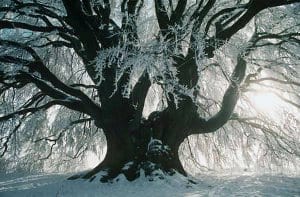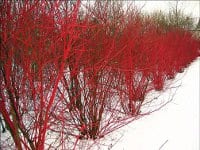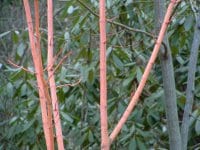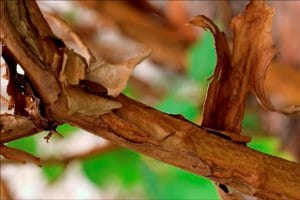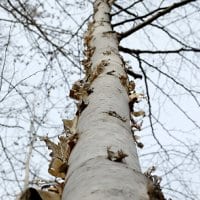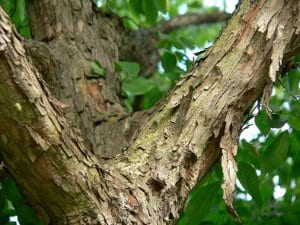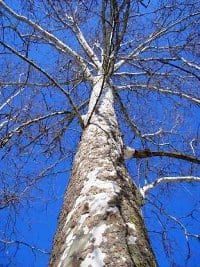In the second of two articles, Scott LaFleur focuses on great New England native plants that introduce wonderful colors and textures of bark into the winter landscape. Incorporate his recommendations in your spring designs and enjoy interesting gardens throughout the winter. This article was adapted from research and a presentation given by Nate McCullin, horticulturist at Garden in the Woods, Framingham, MA.
by Scott LaFleur
I have never been a fan of long goodbyes, and this year Old Man Winter had the joke on us with his April Fool’s snow. I am ready to get the dog days of winter out of here. Where only a few days earlier I was looking for the first emerging trillium, today was a day for bark. The covering of snow made the array of colors and textures barks provide really pop!
In the landscape, trees and shrubs lend not only form but can provide another really great accent when designing a winter garden. Trees and shrubs offer texture on very large scales, similar to the impression you get flying over fields, forests, lakes, and rivers. Trees offer colors, textures, and patterns on a grand scale in the landscape, but also offer the same on a more human scale in their bark.
Seeing Red
Nothing is better in a white landscape than red. It just gives you a warm smile on the bleakest of days when it’s seven below. Luckily we have some really great choices for introducing the warmth of red into the winter landscape.
Swida sericea, the red osier dogwood is a stunning addition to any landscape. This plant really speaks for itself with its multi-stemmed habit and bold red stem color. This is a very versatile addition to the garden that can be used in both formal and naturalistic settings but en masse makes a really dramatic statement. Pathways can disappear in snow overnight, but hedgerows of this shrub are a great way to define the flow and establish a sense of direction. For striking results, use Swida as a vibrant under planting to many Betula species or in the foreground of an evergreen backdrop. Winter-hardy containers planted with Swida are also a good way to define a space and gain some height in the landscape.
To extend color even higher in the landscape, use Rhus hirta, staghorn sumac. Traditionally pigeonholed as a roadside planting, Rhus is breaking through in the horticulture realm with its long lasting bright red fruit and mesmerizing branching structure. Clearly it is the red fruit that draws attention. As your eyes are drawn closer the fuzzy light tan bark sucks you in as you trace the outline trying to find the set of branches that looks like antlers.
As a grazing deer scampers away to ravage my garden, I snap out of my mesmerizing trance staring into the structure of the Rhus and am reminded of one the most majestic beauties for winter interest – Acer pensylvanicum, moose wood or striped maple. The striped maple has a lot to offer over the winter months with its stunning striped bark and natural shrubby form. Reaching heights of 20’ this is a very appealing mid-sized tree with a lot of potential to be used as a specimen and focal point in the landscape. Drawing even more attention like a laser pointer from heaven cv. ‘Erythrocladum’ offers the same white vertical venation but with a strikingly iridescent coral red backdrop. The bark color on both the straight species and this cultivar tend to deepen as winter progresses. By the time there is snow fall, they stick out as if they were illuminated –Mother Nature’s own “glowsticks.”
Peeling Out
Bark that peels is like a shelf built for snow. It breaks the clean vertical line created by the trunk and offers texture and uniqueness. The Cinnamon Clethra is a unique shrub that pulls people in with its flaky bark and showy array of soft brown colors. Seed heads also persist late into winter and work great in holiday arrangements. Maturing at about 10’ tall, often with a greater spread, this shrub can really make an impact. Classic form and multiple stems expose the bark and make a great resting place for a light layer of snow.
In the same vein as the Clethra. Hydrangea quercifolia also combines a classic shrubby form with an abundance of exfoliating stems. The oak-leaved hydrangea distinguishes itself from the Clethra by offering more manageable parameters of 6’ heights and widths. Possessing even more prominent showy flower heads and a fantastic fall color this is a must-have in your garden. Though not a native, honorable mention goes to Acer griseum, paperbark maple. The paperbark maple reaches heights of 20 to 30 feet and boasts reddish brown and light to deep cinnamon colored bark depending on age. Variations in bark exfoliation are really accentuated when a hearty sunset hits the bark at just the right angle illuminating its cinnamon hues. Nonnative plants can have a place in the urban and suburban garden (as long as they are not invasive) – just don’t over do it. Showcasing New England Natives keeps our floral heritage alive.
Place your BETula
You will always win when you bet on Betula species for winter interest offering color, texture, and peeling bark. Betula papyrifera, paper birch, although white, makes a great compliment to the barren landscape winter has to offer. With so many desirable attributes, the paper birch is a great specimen to use as a starting point for creating winter appeal. Its effects are enhanced by placing it in front of an evergreen backdrop or among brightly colored shrubs. While stunning in groupings, this tree also makes a great solo specimen. However, it can look simply abandoned when placed alone in the middle of sea of green. Nonetheless, whether under grey skies or blue this tree is sure to catch your eye.
Betula aleghaniensis, yellow birch, is another eye catcher. The yellow birch tends to stand out due to its large size at maturity. Reaching heights of around 70’ this tree can make an impact with its bark as well as its form. Its dusty yellow fascia sets it aside from the other birches lending a more unique color palette. Combining the color of the Acer grisum with the look of a Betula papyrifera, you get the slightly overused Betula nigra, river birch. The extremely scaly bark, put to the forefront with multiple stems, spans the color spectrum from shades of cream and orange all the way to reds and grays. Most birches begin to exfoliate their bark when they have reached a trunk diameter of roughly two inches.
Look again
While some trees are overused in the landscape trade, others deserve another look. Nyssa sylvatica, black tupeolo, is a beautiful mid-sized tree that reaches heights around 40’ allowing it to display its unique wagon-wheel branching structure. This is a great specimen for a winter “freeze frame.” This is when a coating of ice or snow covers the tree and really accentuates the structure of a tree or shrub. With beautiful glossy leaves and stunning red fall color Nyssa is a great specimen for any time of the year.
Ostrya virginiana, the hop hornbeam, is another versatile specimen tree, with fantastic exfoliating bark that tends to peel back in long vertical strips. The grayish brown bark combined with exfoliation creates a very rough yet pleasant texture in the landscape. Opposite of the Ostrya is a tree of real strength: Carpinus caroliniana commonly known as the American hornbeam. Structure, form, color, and hardiness all contribute to this gnarly native’s well-established reputation. Smooth bark can lead the eye to branch out and take in structure just as it does with the Swida alternifolia, alternate dogwood. Another great specimen, its multi-stemmed layered habit allows S. alternifolia to display a light coating of snow with ease and elegance.
Go Big or Go Home
Sometimes you need to make a statement and be the big tree on campus. These last selections are the big boys of the winter design team. Offering unequaled ecological benefits, big trees will save the world (or so goes my dream). Reaching heights of 100’, Platanus occidentalis, American sycamore, can really make an impact. This tree is hard to overlook due to its mottled brown and white bark and erratic exfoliation habits. Do not confuse the American sycamore with the London sycamore. Use this identification trick: American produces one fruit per stalk; the London yields two per stalk.
Scooby and the gang love this shaggy character: Carya ovata, shagbark hickory. The shagbark hickory offers classic form and size mixed with a unique exfoliation habit. Strips of bark curl away from the trunk like warped boards providing a striking texture at any distance. It’s no mystery to me why this guy wins the winter texture award.
Hidden in the shadows of every winter object is light, but let’s not forget the dark. A snowy canvas on a late winter afternoon is always full of life with dancing shadows. Shadows mimic and distort the form offered from the source and turn a small twining vine into a long curling snake and the smallest shrub into the biggest giant! I love sitting in a warm cozy chair near a big sunny window sipping a glass of Cabernet watching the shadows drift across the landscape and dreaming of the spring to come. Our window to the winter world can often be dreary, but it doesn’t have to be. We can frame it out any way we like!! Whether observing from the kitchen window or passing by on snowshoe our landscape can always have appeal. What lurks in the shadows during the dog days of winter isn’t that scary. But if you do get a little nervous, relax. Trees don’t bite; they just bark.
About the Author
Scott LaFleur is the Horticulture Director and Curator for New England Wild Flower Society’s botanic garden, Garden in the Woods, and for Nasami Farm, a native plant nursery. An accomplished and accessible advocate for native plants and conservation, he brings to his work and public presentations a deep and intimate knowledge of the beauty, hardiness, and versatility of native plants and a deep commitment to organic and ecological gardening. Scott can be reached at slafleur@newenglandwild.org.
Special Acknowledgment
Nate McCullin is Horticulturist and Facilities Coordinator at Garden in the Woods. Nate has a degree in Landscape Horticulture and Plant Science from the University of Delaware. Previously a stock grower at North Creek Nurseries and a former Garden in the Woods intern, Nate has a wide variety of experience in the industry ranging from residential landscaping, to golf courses, to nursery operations, to public gardens. His hands-on techniques in conjunction with a strong horticultural foundation allow him to convey information in a way that both the plantsman and layman can appreciate. He can be reached at nmccullin@newenglandwild.org.

